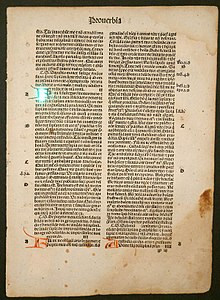
The canons of page construction are historical reconstructions, based on careful measurement of extant books and what is known of the mathematics and engineering methods of the time, of manuscript-framework methods that may have been used in Medieval- or Renaissance-era book design to divide a page into pleasing proportions. Since their popularization in the 20th century, these canons have influenced modern-day book design in the ways that page proportions, margins and type areas (print spaces) of books are constructed.
The notion of canons, or laws of form, of book page construction was popularized by Jan Tschichold in the mid to late twentieth century, based on the work of J. A. van de Graaf, Raúl Rosarivo, Hans Kayser, and others.[1] Tschichold wrote: "Though largely forgotten today, methods and rules upon which it is impossible to improve have been developed for centuries. To produce perfect books these rules have to be brought to life and applied", as cited in Hendel 1998, p. 7. Kayser's 1946 Ein harmonikaler Teilungskanon[2][3] had earlier used the term canon in this context.
Typographers and book designers are influenced by these principles to this day in page layout, with variations related to the availability of standardized paper sizes, and the diverse types of commercially printed books.[4]
- ^ Tschichold 1991, p. 46.
- ^ Kayser 1946.
- ^ Anon. n.d.
- ^ Egger 2004, p. 52.